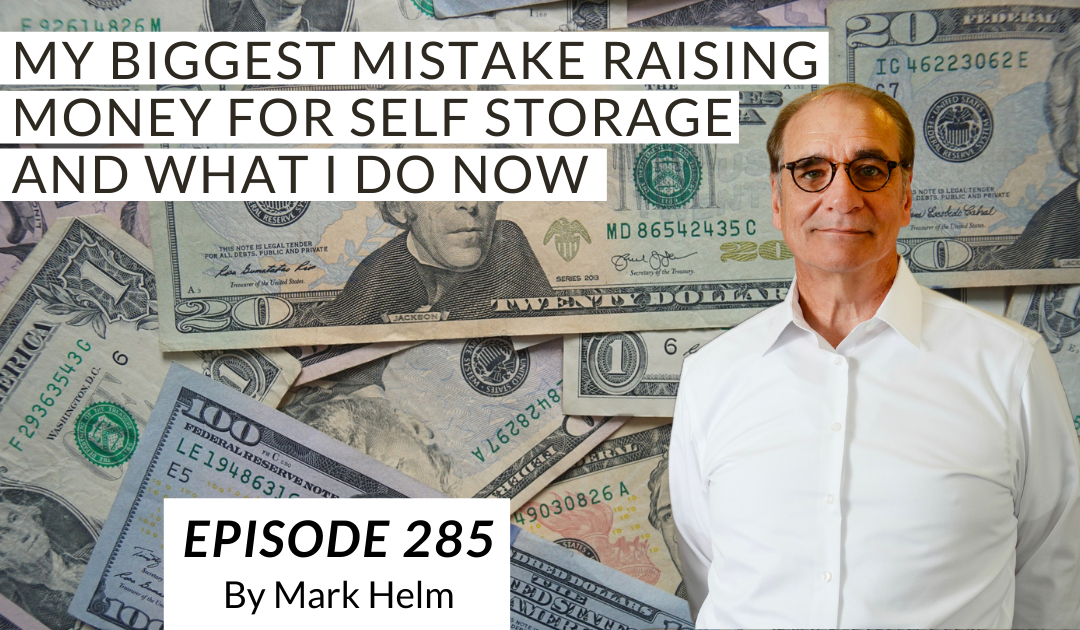Over the years, I have shared how I use other people’s money to grow a self storage portfolio.
For the most part, it has worked well and been a true win-win. Investors get above-market returns with the safest real estate asset as security generating it, and my team gets to manage, nurture, and grow a portfolio.
Most projects I have been involved in have done very well. A few have not done as well as we wanted, and some have not done well, period.
Over the years, I have shared what I have learned and even wrote about one of the projects in my book Creating Wealth Through Self Storage that didn’t do as well as we wanted in the Case Study Section.
My Biggest Mistake
As we grew and began to get a track record of success while the market was heating up, it became obvious that to be able to move as fast as needed during the due diligence phase, I was going to have to raise funds ahead of time, for multiple purchases with one group. Then we could close on the deals faster.
I did that. I shared previous value-add deals we had done, how they were when we purchased them, and what they were like then.
That was the exaptation that was created.
Then as the market continued to heat up, CAP rates got even lower, prices went up, suppliers got even slower in their capacity to fabricate and deliver (six to eight months), we make the usual number of mistakes in planning and execution; our value-add portion of the project took longer.
But that was not the biggest mistake.
Each deal the group would invest in was a value-add project to maximize the returns to the investors. That was my biggest mistake. Not I am not the smartest person out there; just ask my wife.
I spent most of my life doing the opposite of what I am told and what I think I see most people doing.
I have heard all my life, diversify.
Well, I said screw that. I have found something that is fantastic, self storage, and specifically self storage value-add plays, and by God I am going to double down, no triple down on what I do best.
For most of my life, that has worked for me.
It didn’t work well for us over the last few years.
As the market heated up, it took longer to bring expansions to market, lease-up was slower, the anticipated upside seemed further and further away for investors.
Some of the investors felt like their expiations were not being met.
As you know, we promise nothing. In fact, we tell them in the private placement documents we promise nothing, but there still is an exaptation.
Solution
Here is what I know. If we send investors checks and send them on or before they are due, for the most part, investors are happy.
Happy investors are also patient investors. They will not be anxious and allow us to create the maximum value we think we can on a project.
That is what I missed.
I was focused only on doing what I knew to create the maximum amount of “upside” and failed to really think through how investors may perceive what is going on with their investments in a changing market (believe me, I made other mistakes too, but this was the main one I think).
So now, as our team re-invented ourselves in light of the new world in which we find ourselves, and I have been discussing over the past few weeks, here is what we are now doing differently.
We are still focused on raising funds for multiple purchases per investment group, but we are purchasing, or even perhaps putting in our own stabilized facilities, coupled with a few value-add plays.
This allows us to be able to have cash flow from day one for distribution. Yes, it may not be the full preferred return, but my experience is that if investors are getting something, consistently and regularly, while their money is at work creating more value, and they know this ahead of time, they are happy.
Over any given time period, the IRR won’t be as high as perhaps it could be with all value-add plays, but the risk is lowered, and, most importantly, investor expiations are more likely to be achieved.
And happy investors are patient investors.
I didn’t think this through enough in 2016 -2018 and paid the price for it.
If you use investor money for your self storage business growth, no matter if it is a deal at a time or for multiple acquisitions, be sure you consider the evolving market. Let investors know what to expect, when to expect it, and that it could change due to the fast-moving industry. Don’t just use the past but look into the future and see how the changing self storage landscape could affect investor expiations.



